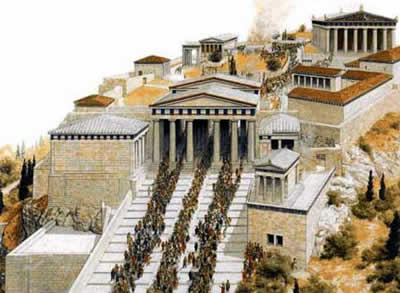 |
| Panathenaic Festival |
The Panathenaic Festival (Panathenaia) was Athens’s most important religious celebration and the second oldest one in the region. During the festival inhabitants of Attica (Panathenaic means "all-Athenian") and other parts of the empire honored the goddess Athena Polias’s birthday (who had leaped from the head of Zeus, according to myth). Since Athena was the city’s protector, the whole festivity had great religious and political significance.
It was traditionally celebrated around the 28th day of Hekatombion, the first month in the Athenian calendar (roughly July), in which some other minor festivals, such as the Kronia and the Synoikia, also took place.
In accordance with tradition it was King Theseus—an Athenian hero closely related to Athena—who instituted the Panathenaia, among other cults (other sources, however, point at Erichtonios as its creator).
  |
Under the archonship of Hippokleides and afterward under Peisistratus (566 b.c.e.) the festival was extended to include a number of athletic competitions and musical performances. The Great Panathenaia—including these games and contests—commenced every four years.
Both literary and archaeological sources concerning the content of the Great Panathenaia are abundant: To some extent the Parthenon frieze is consecrated to the depiction of several episodes of the festival’s procession, and an inscriptional catalog of prizes for the contests of the early fourth century b.c.e. has been found on the Acropolis.
The Panathenaic Games, held during the large-scale festival, included solo and group contests. The athletic competition began with individual gymnastic activities, in which participants from all over the Greek world could take part: footraces (according to their distance they were called stadion, diaulos, dolichos, and hippios), wrestling, boxing, pancratium (a mixture of both boxing and wrestling), pentathlon (which included five events: jump, stade race or dromos, discus throw, javelin throw, and wresting), four-horse and two-horse chariot races, javelin throwing from horseback, and apobatai (hoplites getting on and off moving chariots).
Team contests were reserved to Athenian citizens and included a mock combat with cavalry (anthippasia), a beauty competition among athletes (euandrion), military dancing known as the pyrriche, and a regatta. In general, prizes for the winners consisted of amphoras filled with olive oil, since olive trees were especially sacred to the goddess Athena.
The festival also included poetic and musical competition, open to participants from all over Greece. There was a rhapsodic contest on recitation of Homeric texts and other epic poetry, and several prizes were offered for the best singers and players of instrumental music (on the kithara and aulos).
Once Pericles had built the Odeion, these activities are believed to have taken place there. In the evening a torch race (lampadephoria) was organized; the fire was brought from the altar of Eros in the Academy, and a nocturnal celebration with dances and singing (pannychis) followed.
The Panathenaic procession, which was organized the following day, was one of the most distinctive aspects of the festival, and its origin could perhaps date from the seventh century b.c.e.
Every year a special robe (peplos) was woven and decorated, as a gift for Athena, by working maidens (ergastinai) carefully chosen from Athenian aristocratic families. Being selected to work on the cloth was an important civic honor.
The parade (pompe) started early at the Dipylon Gate, in the northern part of the city, and walked through the Agora to the Acropolis into the Erechtheion, to finally place the new embroidered peplos, dyed in saffron, on a human-scale statue of Athena Polias.
Maidens with head baskets (kanephoroi), the ergastinai, and several men from all ages and classes took part in the procession as well. Even metics (residents of Attica who were not properly citizens) joined the procession, serving as skaphephoroi and carrying offerings, such as cakes and honeycombs.
However, they could not follow the whole parade up to the Acropolis, as they had to stay at the gateway, or propylaia. A large hecatomb was made afterward upon the altar of Athena, and meat from sacrificed cows and sheep was used in a ritual meal at the end of the festival.
Attendance to the banquet was proportionally distributed on the basis of demes (local districts of Attica). As a whole the Panathenaic Festival was not only the celebration of a sacred cult but also a dynamic spectacle where the power of Athens was expressed and where the ideology of political supremacy was largely confirmed.